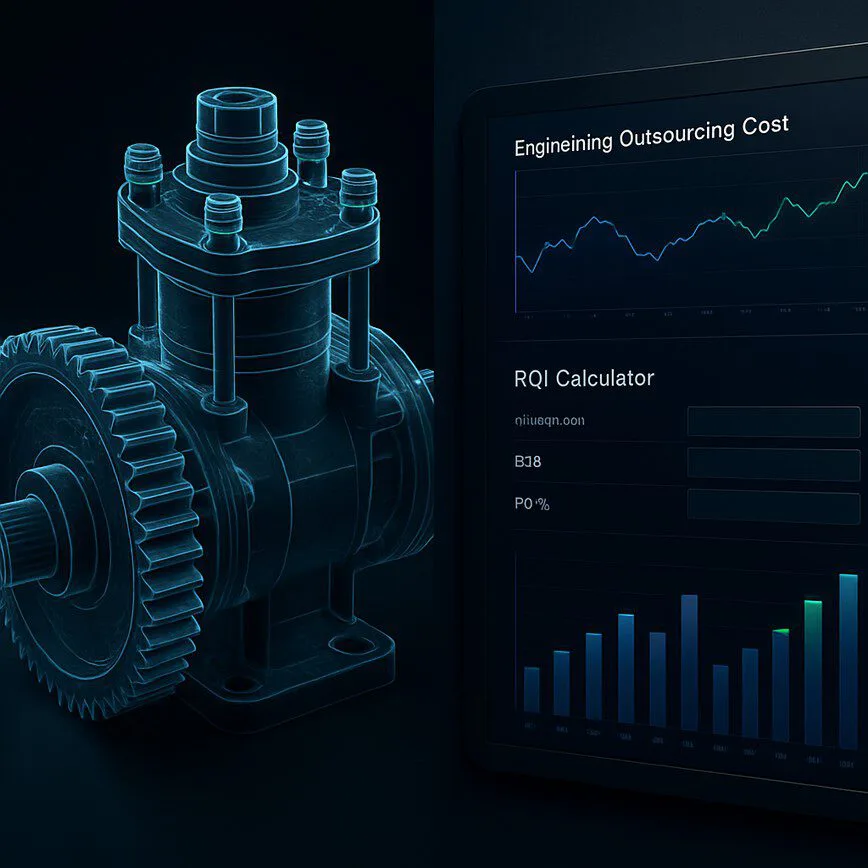Understanding the true engineering outsourcing cost can feel like trying to solve a complex equation with too many variables. You know outsourcing can unlock innovation, speed up time-to-market, and provide access to specialized skills, but the lack of transparent pricing often becomes a major roadblock. How can you budget effectively when every potential partner provides a different answer—or no answer at all? This ambiguity can stall projects and create uncertainty at a critical stage of planning.
Table of Contents
- Why Is It So Hard to Get a Straight Answer on Engineering Outsourcing Costs?
- Key Factors That Influence Outsourced Engineering Services Pricing
- Common Pricing Models Explained
- What to Expect: Average Cost Ranges for Outsourcing Engineering in 2025
- How to Find Affordable Engineering Outsourcing Without Sacrificing Quality
- Beyond the Hourly Rate: Uncovering Hidden Costs
- Making an Informed Decision
In any technical field, making informed decisions with confidence is paramount. The principle is simple: clarity is key. Just as you’d use an ROI calculator to understand the long-term value of a major investment, you need a clear framework to evaluate the cost of outsourcing engineering. This guide is designed to demystify outsourced engineering services pricing for 2025, giving you the insights to plan your budget and choose the right partner with confidence.
Why Is It So Hard to Get a Straight Answer on Engineering Outsourcing Costs?
The primary reason for the wide range in pricing is that “engineering” is not a monolith. An engineering project can range from simple 2D drafting for a legacy part to complex, multi-year research and development for a new aerospace product. The skills, tools, and level of responsibility required for mechanical, electrical, software, and civil engineering are vastly different. The final price tag is a reflection of a project’s unique demands, encompassing the specific discipline, required certifications, and level of innovation involved. A one-size-fits-all price simply doesn’t exist, and any firm offering one is likely overlooking critical details that could lead to scope creep or subpar results down the line.
Key Factors That Influence Outsourced Engineering Services Pricing

To accurately estimate your costs, you need to break down the key drivers. Each of these elements plays a significant role in the final quote you receive. Understanding them allows you to have a more productive conversation with potential partners.
Project Scope & Complexity
This is the biggest cost determinant. A project requiring basic mechanical drawings or 3D modeling from existing sketches will cost significantly less than one involving advanced simulations like finite element analysis (FEA), computational fluid dynamics (CFD), and new product prototyping. Consider the depth of work needed: does the project involve regulatory compliance (e.g., FDA, FAA), advanced materials science, or the development of complex embedded systems? The more specialized the work, the more rigorous the process, and therefore, the higher the cost.
Engineer Expertise & Experience Level
You get what you pay for. A team of senior engineers with 10+ years of experience, specialized certifications, and a portfolio of successful projects will have a higher hourly rate than a team of junior engineers. However, for critical projects, this higher rate often translates to lower total costs. The experience of a senior team can prevent costly errors and delays, providing a much higher return on investment. They can anticipate manufacturing challenges, optimize designs for performance and cost, and require less oversight from your internal team, freeing up your resources.
Geographic Location of the Outsourcing Partner
Where your outsourcing partner is located has a massive impact on labor costs. Rates can be broadly categorized by region, each with its own set of advantages and considerations:
- North America & Western Europe: These regions command the highest rates due to high labor costs and standards of living. The primary benefit is proximity, which offers minimal time zone differences, cultural alignment, and easier collaboration for US and Western European companies. This can be critical for projects requiring constant communication and rapid iteration.
- Eastern Europe: Often considered the “sweet spot” for value, this region offers a mid-range option known for its strong technical universities, a deep talent pool in STEM fields, and high-quality work. Countries here provide a significant cost advantage over North America without a major sacrifice in skill or communication proficiency.
- Asia (India, Philippines, Vietnam): This region generally offers the most cost-effective rates due to lower labor costs. It boasts a vast, scalable pool of engineering talent, making it an excellent choice for large-scale projects or tasks that can be clearly defined and managed remotely.
Engagement Model
How you structure the partnership directly affects the billing. We’ll explore these models in more detail below, but the choice between a fixed price for a defined outcome and a flexible hourly rate for an evolving project will fundamentally change your cost structure and risk profile.
Technology & Software Requirements
Does your project require licenses for specialized, high-end software like SOLIDWORKS Premium, CATIA, Ansys, or Autodesk Inventor? The cost of these powerful tools is often factored into the overall project price. Why this matters: a partner firm that already holds these licenses can provide you with access to this technology without you needing to make a large capital investment yourself. Furthermore, the cost isn’t just the license fee but also the deep expertise required to leverage these complex platforms effectively.
Common Pricing Models Explained

Understanding these models is crucial for finding a partnership that aligns with your project goals and budget. The right model provides the right balance of flexibility, predictability, and control.
Fixed-Price Model
- How it works: A total, fixed price is agreed upon for a clearly defined scope of work before any work begins. This scope is meticulously documented, including all deliverables, milestones, and timelines.
- Best for: Projects with well-documented requirements, a stable design, and a predictable timeline, such as converting 2D drawings to 3D CAD models or performing a standard analysis on an existing design.
- Pros: Budgetary certainty. You know the exact cost upfront, which simplifies financial planning and eliminates the risk of cost overruns, assuming the scope doesn’t change.
- Cons: Inflexible. Any changes to the scope (scope creep), no matter how small, will require a formal change order, a new quote, and a contract amendment, which can cause delays and friction. This model can also discourage innovation if a better approach is discovered mid-project.
Time & Materials (T&M) Model
- How it works: You pay an agreed-upon hourly or daily rate for the time spent by the engineering team, plus the direct cost of any materials, software licenses, or other resources used.
- Best for: Complex, long-term projects where requirements may evolve, such as new product development, research and development (R&D), or projects using an Agile methodology.
- Pros: High flexibility to adapt and iterate as the project progresses. You can change direction, adjust priorities, and refine the scope based on new insights without needing to renegotiate the entire contract.
- Cons: Less budget predictability. This model requires a high degree of trust in your partner and diligent project management from your side to monitor progress and keep costs in check. Without clear communication and reporting, costs can escalate unexpectedly.
Dedicated Team Model
- How it works: You hire a full-time team of engineers from the outsourcing company who work exclusively on your projects for a flat monthly fee. This team functions as a direct extension of your in-house staff.
- Best for: Companies needing a long-term, integrated extension of their in-house team to handle a continuous stream of work or a large, multi-year program.
- Pros: Deep integration, high level of control, and accumulated project knowledge. The team becomes deeply familiar with your products, standards, and culture, leading to increased efficiency and innovation over time.
- Cons: Higher financial commitment than a single project. This model is less cost-effective for short-term or one-off projects, as it’s structured like a retainer.
What to Expect: Average Cost Ranges for Outsourcing Engineering in 2025
While a precise quote requires a detailed project brief, we can provide some general hourly rate ranges based on location and experience. It’s important to remember that these figures represent the cost of the engineer’s time and expertise. They may not include additional costs like project management, specialized software, or administrative overhead. Use these as a starting point for evaluating the cost of outsourcing engineering.
- North America (USA/Canada): $100 – $200+ per hour
- Western Europe (UK/Germany): $80 – $150 per hour
- Eastern Europe (Poland/Ukraine): $40 – $70 per hour
- Asia (India/Philippines): $25 – $50 per hour
Disclaimer: These are industry estimates. Rates can vary based on project complexity, team size, and the provider’s reputation. A firm with a proven track record in a niche, high-stakes field like medical device engineering will naturally command higher rates than a generalist CAD drafting firm.
How to Find Affordable Engineering Outsourcing Without Sacrificing Quality
The goal isn’t just to find the cheapest option, but the best value. True affordable engineering outsourcing delivers high-quality results that accelerate your project and don’t require expensive rework, ultimately saving you money and time.
- Prioritize Expertise: Look for a partner with a comprehensive knowledge base and a proven track record in your specific domain. A specialist firm brings targeted expertise that a generalist cannot match. Ask to see case studies, examples of past work, and the credentials of the engineers who would be assigned to your project.
- Demand Transparency: A trustworthy partner will be open and clear about their pricing models, communication protocols, and project management processes. They should be able to explain exactly what is included in their quote and what might be considered extra. A lack of transparency is a major red flag.
- Focus on Total Value: Use tools and frameworks to evaluate the long-term benefits beyond the hourly rate. A good partner helps you understand the return on investment, much like an ROI calculator helps quantify the financial benefits of a large capital expenditure. This “total value” includes faster time-to-market, reduced load on your internal team, and mitigation of design risks.
Beyond the Hourly Rate: Uncovering Hidden Costs
Your budgeting shouldn’t stop at the quoted price. A savvy project manager anticipates and plans for all potential expenses. Be mindful of potential hidden costs that can inflate your total investment:
- Project Management Overhead: Who will manage the outsourced team and serve as the main point of contact? Factor in the time cost of your internal staff who will be dedicated to overseeing the project, reviewing deliverables, and providing feedback. This is a real cost to your business.
- Onboarding & Communication: Time spent getting the new team up to speed on your standards, processes, and project goals is an investment. Effective communication requires setting up channels, regular meetings, and potentially overcoming language or cultural barriers, all of which consume resources.
- Quality Assurance & Rework: This is the most dangerous hidden cost. A low-cost provider may deliver subpar work that contains errors, fails to meet specifications, or is poorly documented. The cost of having your in-house team fix these issues can quickly negating any initial savings and delay your entire project timeline.
- Infrastructure & Security: Ensuring data security and compatible IT infrastructure can add costs. This includes protecting your intellectual property (IP) with robust NDAs and secure data transfer protocols, as well as ensuring the partner’s systems can handle your large data files without issue.
Making an Informed Decision
Choosing to outsource engineering is a significant strategic decision. By understanding the factors that drive cost, the different pricing models available, and the potential hidden fees, you are empowered to make a choice that aligns with your financial and project goals. A successful partnership is not about finding the lowest price, but the greatest value. The right partner will not only fit your budget but will act as a true extension of your team, driving innovation and delivering exceptional value that propels your business forward.
As you move from understanding the costs to selecting a partner, it’s helpful to explore the different ways these services can be structured. To learn more about the strategic benefits and key considerations, we recommend reading our comprehensive overview of engineering services outsourcing. This resource provides a deeper dive into the “what” and “why” behind building a successful outsourcing partnership.

